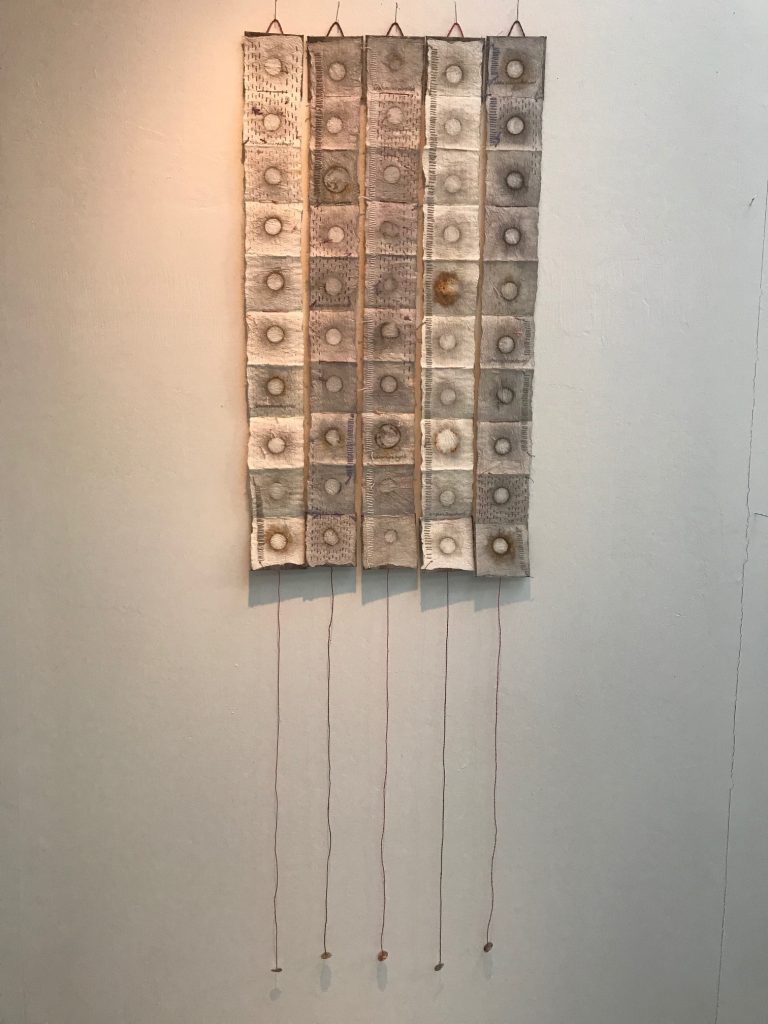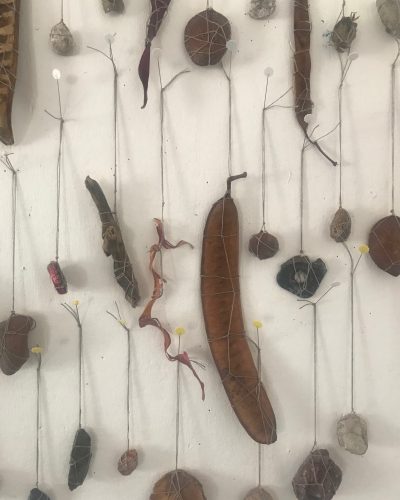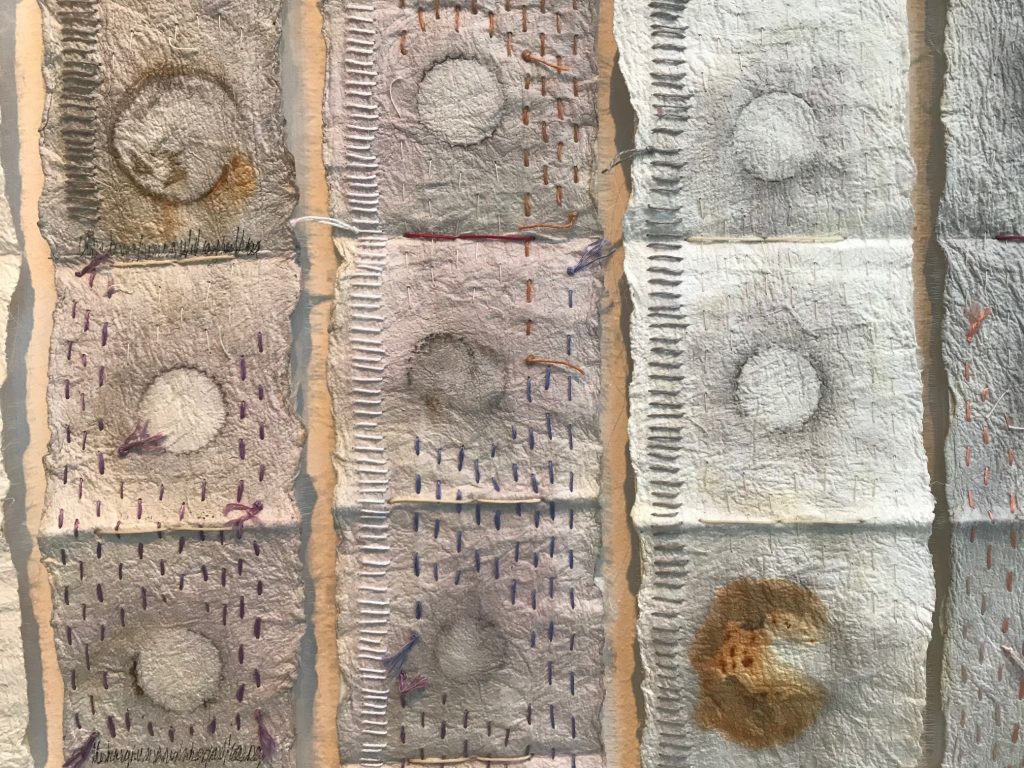
Saaraliisa Ylitalo’s three-month personal residency generated work and conversation about artist books, joomchi and the power of art to heal. We share Saaraliisa‘s fascinating life as a Global Nomad and the influences from her years in Japan, Costa Rica, Peru and South Africa.
You have spent a great deal of your life living abroad. Tell us about where you have been and how this has influenced your art.
Both my father and husband were in the Foreign Service, which made me a world traveler (also known as a Global Nomad). Here are some places and things that have a power and wonder that have gone straight into my heart and come out in my work:
I am in awe of all forms of ritual and gratitude whether secular or spiritual and I am moved by places where our shared connection is profoundly evident.
- Pre-Columbian gold work in Peru
- Daily offerings and personal altars everywhere in Bali
- Milagros all over Latin American churches
- Historical ruins in Machu Picchu, Ollantaytambo, and Sacsayhuaman, all in Peru.
- Hieroglyphics, cave paintings and nonverbal forms of communication from many old cultures
- Magical cites of the world that are special to me: Kyoto in Japan, Oaxaca in Mexico, Cusco in Peru and, Chichicastenango in Guatemala.


We would love to hear about your mentors, education and artists whose work has had the most impact on you.
In my twenties I studied with Walter Nottingham and taught various fiberarts in Illinois and Wisconsin. Then I began 25 years of travel on four continents–living, teaching and exhibiting in Costa Rica, Japan, Peru and South Africa. During five years in Japan, I fell in love with washi paper and apprenticed with a master papermaker in Kyoto. Paper remains my chief passion but I combine it with many other textile techniques including spinning paper thread (koyori or kami-ito) and a Korean technique called Joomchi, in which layers of paper are agitated together and form a strong paper felt.
I love so many artists but here are some of my all-time favorites: Magdalena Abakanovitz, Agnes Martin, Mark Rothko, Frida Kahlo, Lenore Tawney, Eva Hesse and Louise Bourgeois.
For many artists who work in fiber, there are childhood experiences that have drawn us to working with particular materials or aesthetics. Tell us about some of your fiber lineage.
Textiles have always fascinated me. I learned to sew when I was nine, and everything else followed: knitting, crocheting, weaving, spinning, dyeing, tatting…. By the time I got to college, I was ready to explore textiles as art.
Transparent Japanese paper appears as thin and fragile, but is so much stronger than other papers. Working with these contrasting qualities fascinates me and reflects how I feel about finding strength in each fragile moment. My Finnish background and many years in Japan have made me aware that these two disparate cultures both have an esthetic sparseness and “less is more” quality that I am deeply drawn to. Ethereality in my work is just part of how I speak visually. The Scandinavian esthetic is in my genes but my materials are distinctly Asian.


There are some persistent visual themes in your work: aged and rusted surfaces, grids and series, text and thread and using gold. Tell us about these aspects of your work and what you love about them.
Using text conveys the maker’s hand, our universal need to communicate and the healing process of journaling. I often use text from Rumi’s poetry, which is full of sensitivity and grace. The hanging threads reference an unfinished thought and a stitched line, the written word. I have used rust in my work for a long time. Its beauty speaks to me of the impermanence of everything and the beauty in aging and decay.
I always work in a series, until I have exhausted the thought or idea. It is a part of the philosophy I learned from Walter Nottingham about structuring my freedom. I take an idea and work with it in all different manifestations of the theme within my chosen limitations. I always use paper as if it were fabric, use textile techniques (so dye and not paint), and I almost always use gold. I am always trying to depict a moment of joy or a moment of despair, and the tension between the two. Gold has a larger voice in some work and barely a voice in others. Yet even in the bleakest subjects I use gold to signify a way out of despair. I strive to translate our internal weather systems into visual form.

Everyone needs support for their art. Tell us about your artistic support network when you lived abroad and who supports you now that you have returned to the US?
From the beginning my husband was always my best cheerleader. He was very well educated in all the arts, not because he was a maker, but because he was a voracious reader and curious about everything and he often helped me with references. We all need a place to air thoughts and ideas where it is safe and where we are completely seen and not judged and he provided this for me. Since his sudden death in 2015 I have struggled to find support and I realize that I will find it in many different places, not just in one person. For an introvert, this is not easy, but I am working towards extending my circle, and bringing new people into my life to share my art, ideas and feelings.
You are on a three-month personal residency in Chapala. Tell us why you are drawn to Mexico and how you visualize your time here.
Choosing to be in Mexico was easy because I speak Spanish and feel at home in this culture. People are kind and friendly in Chapala and it is a very welcoming place. It is no surprise I feel more at ease outside of the US. This residency is about art and healing. My best survival tool is my art, so I needed a space to take the time without the responsibilities of home life.
Read more about Saaralissa:
www.saaraliisa.com
Instagram: @saaraliisa

